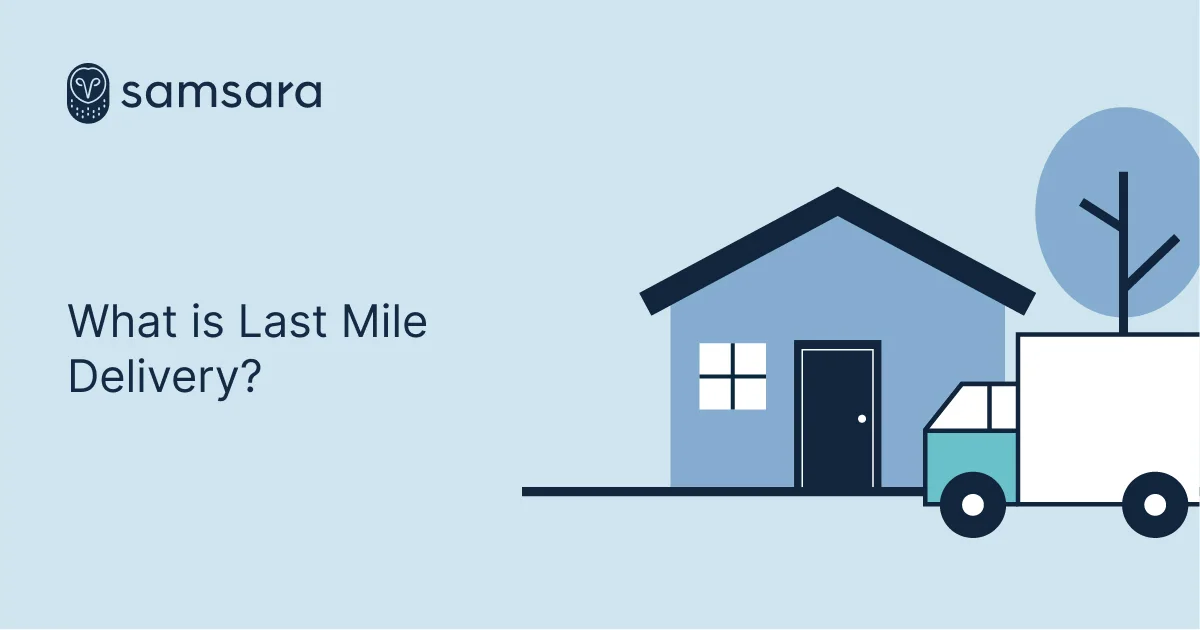What is Last Mile Delivery?
October 25, 2021

Get Started With Samsara
Check Our PricesKey Takeaways
Last mile delivery has become a key differentiating factor for retailers. However, aside from being a key part of customer satisfaction, last mile delivery is the most time-consuming and expensive part of the shipping process. Learn more about the challenges of last mile delivery and some solutions to improve efficiency.
What is last mile delivery?
“Last mile” delivery is transporting goods from a transportation hub to a final destination (often a private residence). It’s called the “last mile” because it’s the final step of a product’s journey to the buyer. Thus, it’s also known as final mile delivery.
Aside from being a key part of customer satisfaction, last mile delivery is the most time-consuming and expensive part of the shipping process. Last mile logistics has become a popular subject for retailers due to the growth in online shopping and ecommerce sales. Evolving consumer demand has forced retailers to make adjustments to their supply chains to accommodate buyers.
Why is last mile delivery important?
Last mile delivery has become a key differentiating factor for retailers. Online ordering has made it easy for consumers to buy products from anywhere, anytime. If they have a poor experience with a seller, they can move on to another one, making competition fierce amongst retailers. That means sellers need to offer exceptional customer experiences to retain and grow their business.
Today’s customers have high expectations when it comes to last mile delivery. Retailers like Amazon have elevated customer experience with next-day and same-day delivery services and real-time delivery tracking. To compete, other retailers need to find innovative ways to get their products in the hands of their customers as fast as possible.
Challenges of last mile delivery
Ironically, while last mile delivery is often the shortest leg of the delivery process, it’s often the most challenging and costliest. These last mile problems are what retailers and transportation service providers are constantly trying to enhance the delivery experience.
1. Late deliveries
Retailers rely on a network of partners to get their products to customers. These could include logistics companies, fulfillment centers, and other order fulfillment businesses. Delays can occur anywhere along the way, causing a breakdown in promised delivery timelines. These delays can harm a brand’s reputation and cause customer churn.
2. Routing
Delivery services tend to be inefficient by nature, involving multiple stops with low drop sizes. Urban areas have stops within close proximity, but traffic congestions and parking issues delay delivery times. On the other hand, rural areas may have stops that are miles apart. Poor route planning can lead to inefficiency and customer frustration.
3. High delivery costs
Last-mile delivery is costly for both sellers and buyers. For sellers, a swift-moving delivery infrastructure is costly to maintain. They need to factor complex routes, third-party logistics, failed deliveries, fleet operations, and employee salaries into their budget. When a delivery attempt fails and needs to be rescheduled, that adds to the total cost.
Some of these costs get passed on to customers, but it’s a double-edged sword. With many retailers offering “free shipping,” customers are less willing to foot the bill, causing retailers and logistics partners to cover costs. Costly shipping fees and high delivery costs might cause customers to abandon their carts altogether.
4. Lack of visibility
Today’s buyers not only want fast delivery, but they also want visibility into the delivery process. They want to know the location of their packages to track progress and when it will reach them, down to the day and preferably the time of day.
Many businesses now offer tracking codes to track shipment status. However, customers now want real-time locational information so they can be prepared for home delivery.
Last mile delivery solutions
To keep up with customer expectations, businesses are developing new technologies and experimental supply chain models to improve last mile delivery efficiency while cutting costs. Some solutions include:
Route optimization
Companies are leveraging software to help with dispatch routing. Fleet software solutions automatically account for location, real-time traffic updates, and time to recommend the most efficient routes. Drivers can receive route updates via mobile app or SNS.
Updated technology solutions
Today’s software helps prevent delays, improves supply chain visibility, and reduces transportation costs. Real-time GPS tracking and Industrial Internet of Things (IIoT) technology installed in delivery vehicles helps retailers and distribution partners monitor every aspect of the last mile journey. Using these tools, supply chain managers can automate vehicle dispatching work, communicate with customers, predict delays and take action to avoid them.
Crowdsourcing
Consumers are already used to crowdsourced, “gig-economy” services through ridesharing and food delivery businesses like Uber, Lyft, and DoorDash. Retailers and logistics providers are experimenting with non-professional couriers — who use their own transportation — to deliver packages faster.
Micro-fulfillment and retail distribution centers
Another tactic is to reduce the proximity between sellers and buyers. Micro-fulfillment brings smaller-scale fulfillment operations to warehouses in urban areas for faster deliveries to end users. Micro-fulfillment centers can have highly automated warehouse operations or be as simple as local store pick-ups.
Click and collect model
Like micro-fulfillment which brings products to end users faster, the click and collect method takes this one step further and shifts some of the work to customers. Click and collect allows customers to choose a local store and a specific time to pick up their goods. It could be a brand’s local retail location, a partnership with another local store, or a storage locker where customers can retrieve their purchases. This method reduces delivery route complexity while also streamlining delivery activity to reduce costs.